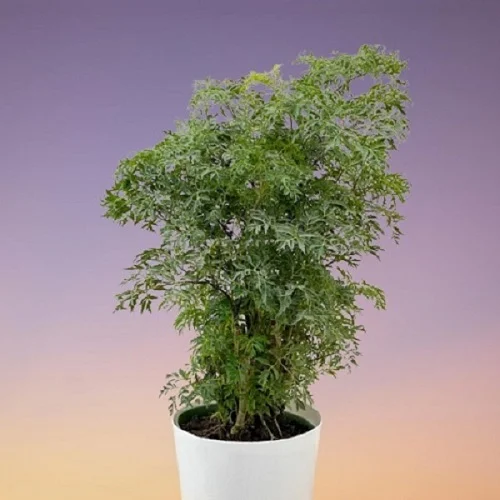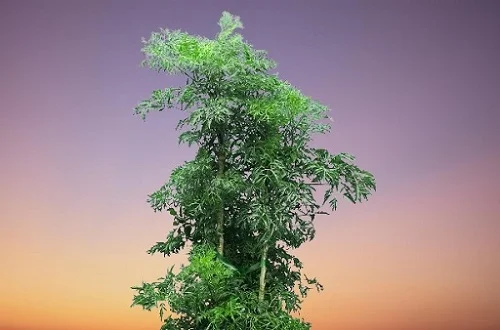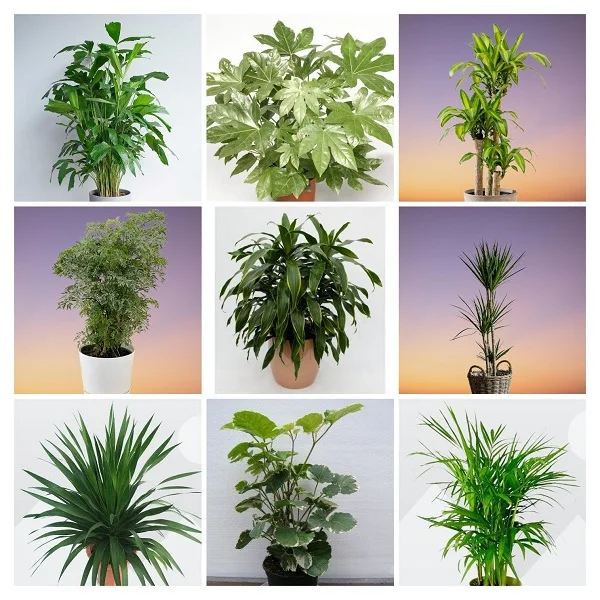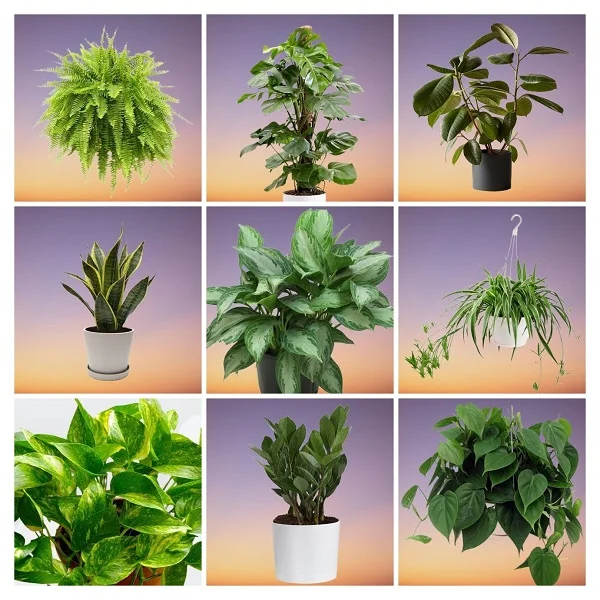Ming Aralia (Polyscias fruticosa) Indoor Care, Common Problems and Remedies
Some links in this post may be affiliate links
Ming Aralia (Polyscias fruticosa) flourishes in bright light, average warmth, humid conditions and moderately moist, rich, well-drained soils coupled with monthly feeding in the growing season.
Polyscias fruticosa is one of the best indoor trees and bears dark-green, glossy leaves which appear divided and are about 10 cm long.
Ming Aralia is a perennial, evergreen shrub or dwarf tree which grows slowly but can eventually reach the height of 6 feet. The ferny leaves droop gracefully from narrow branches that grow straight up and forms a multi-layered beautiful plant.
The leaves have been used as a tonic, anti-inflammatory, antitoxin, and an antibacterial ointment. They have also been proven to aid in digestion and thus, have been used as a spice.

Botanical name: Polyscias fruticosa
Family: Araliaceae
Common name: Ming Aralia
Origin
Polyscias fruticosa was originally found in Polynesia where it thrives in environments of medium humidity, with temperatures ranging from 16-290C.
Size
Ming Aralia can grow to a height of 3-6 feet when given the right growing conditions indoors.
Types of Polyscias Varieties
Types of Polyscias that can be grown indoors include;
Polyscias scutellaria, commonly called Shield Aralia and
Polyscias balfouriana, commonly called Aralia balfouriana.
Is Polyscias fruticosa pet-friendly?
Polyscias fruticosa is toxic to pets as indicated by ASPCA. It contains saponins which if ingested will cause swelling and burning in the mouth and throat, vomiting, diarrhea and abdominal pains.
Where to Buy
If you are looking to add Ming Aralia to your collection, they are available online on Amazon (Link to Amazon) and on Etsy (Link to Etsy).
Caring for Polyscias fruticosa Indoors
In this comprehensive care guide, we cover light, watering, humidity, soil, fertilization, pruning, repotting, common problems, and FAQs to help you grow a healthy and vibrant Ming Aralia indoors.
Ming aralia does well in bright light, average warmth of 18-280, humidity of 55-65% and moderately moist, fertile, well-drained, all purpose potting soils coupled with monthly feeding during the growing season.
Polyscias fruticosa requires regular pruning to keep it neat, promote a bushy growth and rejuvenate growth. Repotting is needed every 2-3 years when it has outgrown its pot as it grows best when pot-bound. Keep reading for more on these growing conditions and how to achieve them.

Watering
Water your Ming Aralia liberally during the growing season and allow the top 1-2 inches of soil to dry out slightly between waterings. Keep the moderately moist but not soggy to avoid yellowing and leaf drop.
Cut down on watering in the cold period as growth is minimal at this time. Do not allow the soil to dry out completely as it may cause the Ming Aralia to drop all its leaves.
Ensure that the pot has a drainage hole to prevent the soil from getting soggy. Ming Aralia does not like to sit in soggy soil as it is prone to root-rot which can cause the plant to die.
Use room-temperature water to avoid shock which can lead to leaf drop. Only water with filtered water to avoid accumulation of excess chemicals in the soil.
Light Requirements
Ming Aralia grows best in bright light. Keep it away from direct sunlight to avoid scorching. However, it will adapt to light shade though it will grow much slower in such conditions.
Too little light will result in yellowish leaves and leggy growth. Move the plant to a brighter spot or consider investing in a grow light if the natural lighting is not enough.
Regularly turn the pot to ensure that the plant receives light on all sides for uniform growth to prevent unbalanced growth.
Temperature and Humidity
The best temperature for Ming Aralia is average warmth of 18-280 with a minimum of 160C. Keep it away from cold drafts as it doesn't like cold temperature at all. Cold temperatures may result in reduced growth and leaf drop.
Ming Aralia requires a high humidity of 55-65% to thrive. If humidity is too low the plant will respond with brown leaf tips. To raise humidity, set the pot on a wet pebble tray or use a cool mist humidifier. Do not mist the leaves to prevent fungal diseases.
Potting Soil
The best mix for Ming Aralia should be a well-draining, nutrient-rich potting mix to prevent it from getting soggy while providing the required nutrients. All purpose potting mixes are great for the plant.
Fertilizer
Feed your Ming Aralia monthly with a balanced water-soluble fertilizer during the growing season. Do not feed in the cold season as growth is minimal at this time.
Leaf browning and a white crust on the soil surface indicate a build up of fertilizer salts. Flush out the accumulated salts arising from fertilizers every 2-3 months by running a stream of water through the soil until the water comes out through the drainage holes. Let the stream of water run for a few minutes and repeat the process several times.
Repotting
Repot your Ming Aralia every 2-3 years only when they have outgrown the current pot as it grows best when pot-bound. Use a pot one size larger than the current one. Tto control growth, keep Ming Aralia slightly root-bound by avoiding oversized pots. Ascertain that the pot has a drainage hole to avoid getting soggy soil as it can lead to root-rot. Check out these self watering planters on Amazon.
Pruning & Grooming
Pruning Ming Aralia requires pinching-back of the growing tips to encourage a bushy and compact growth. Remove yellow and dead leaves to keep the plant neat and reduce pests and diseases. Cutback the overgrown plant with a clean pair of pruning scissors to rejuvenate growth.
Regularly clean the leaves by splashing a lot of water from a strong jet to get rid of dust and also reduce pest infestations.
Propagation
Polyscias fruticosa (Ming Aralia) is best propagated at the beginning of the growing season (spring) by air layering or from stem-tip cuttings which can be rooted either in soil or in water. Propagating the plant at this time hastens establishment as it is in the active growth phase.
Read more on how to propagate Polyscias fruticosa (Ming Aralia) in 3 Easy Ways.

Polyscias fruticosa Growing Problems
Ming Aralia (Polyscias fruticosa) growing problems include leaf drop, leaf spots, plant dying, wilting (drooping), yellowing, pests and diseases among others. Keep reading for more on these problems and how to fix them.
Yellowing and wilting leaves
Yellowing and wilting (drooping) leaves in Ming Aralia is an indication of root-rot which is promoted by soggy soil. To save the plant, take it out from its pot, clean off the soil from the roots and inspect the roots.
Cut away brown-black mushy roots and treat the remaining roots with a fungicidal solution. Clean and disinfect the pot with the fungicidal solution and repot the plant in fresh soil. Keep it dry for a few days before beginning the regular watering.
Make sure that the soil is free-draining and the pot has a drainage hole to avoid getting soggy soil in the future. Allow the soil to dry out slightly between waterings. Never allow the plant to sit in soggy soil.
Dropping (shedding) leaves
Some leaf drop in Ming Aralia is normal. However, a sudden change in lighting and watering will cause excessive leaf drop. Avoid sudden changes in the growing conditions. Acclimate it gradually over a period of time before changing its position.
Plant dying
Soggy soil for Ming Aralia will result in death of the plant due to root-rot which is promoted by soggy (too wet) soil. Ensure that the soil is free-draining and the pot has a drainage hole to avoid getting soggy soil.
Allow the soil to dry out slightly between waterings and maintain the soil moderately moist during the growing season. Maintain the soil slightly moist in the cold season as growth is reduced at this time. Learn more on how to water houseplants the correct way.
Pests
The common pests in Ming Aralia are spider mites especially where air humidity is too low or there is inadequate watering.
Raise humidity to discourage future pest infestation by setting the pot on a wet pebble tray or use a cool mist humidifier. Maintain the soil moderately moist and never allow the soil to dry out completely to discourage pest infestation.
Yellowish-green young leaves
Lack of nutrients is the cause of yellowish-green young leaves in Ming Aralia. The plant requires regular feeding during the growing season. Feed the plant monthly with a balanced water-soluble fertilizer during the growing season but do not feed it in the cold period. Learn how to feed houseplants.
Brown leaf spots
Brown leaf spots in Ming Aralia are caused by underwatering as it thrives in moderately moist soil. Never allow the soil-ball to dry out. Maintain the soil moderately moist at all times during the growing season and slightly moist in the cold season.
Conclusion
Ming Aralia (Polyscias fruticosa) is a low-maintenance, elegant houseplant that thrives in bright indirect light and warm, humid conditions. By providing moderate watering, occasional pruning, and proper humidity, you can enjoy a lush, tropical plant for years.
Frequently Asked Questions
1. Can Ming Aralia tolerate low light?
Yes, Ming Aralia can adapt to low-light conditions, but it thrives best in bright indirect light.
2. Is Ming Aralia toxic to pets?
Yes, Ming Aralia is toxic to cats and dogs if ingested. Keep it out of reach of pets.
3. How often should I water my Ming Aralia?
Check the moisture in the top 1-2 inches of soil. If it feels dry, water, if it feels wet, do not water. Do not water on a schedule.
4. What is the best pot for Ming Aralia?
A ceramic, terracotta, or plastic pot that has drainage holes is ideal for Ming Aralia to avoid getting waterlogged soil.
5. Can I propagate Ming Aralia from cuttings?
Yes. Ming Aralia propagates best from stem cuttings. Cut a 4-6 inch stem, dip it in rooting hormone, and place it in moist soil or water until roots develop.
You liked it? Share on social media.
Related Content
Amazon Associates Disclosure
Homeplantsguide.com is a participant in the Amazon Services LLC Associates Program, an affiliate advertising program designed to provide a means for sites to earn advertising fees by advertising and linking to amazon.com.





